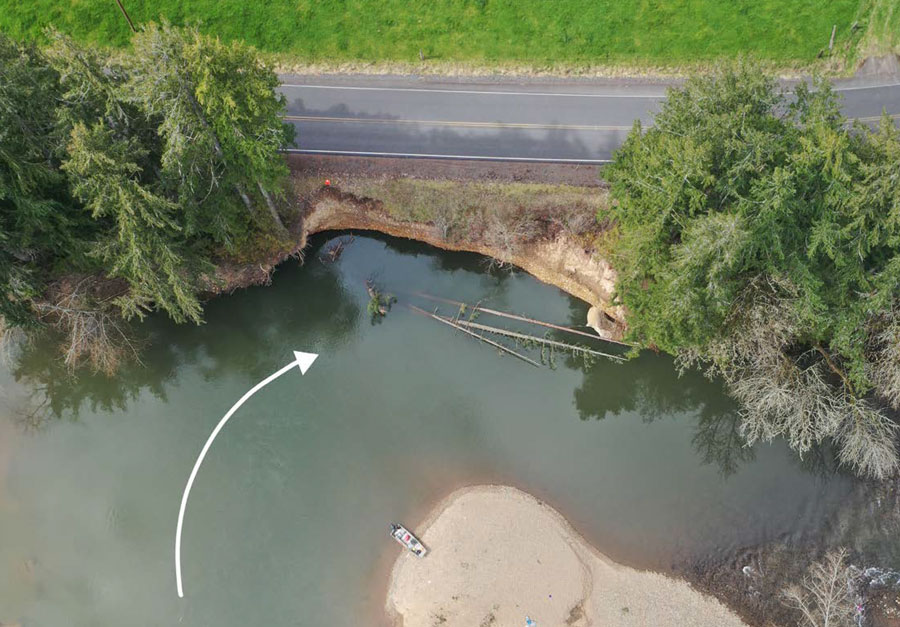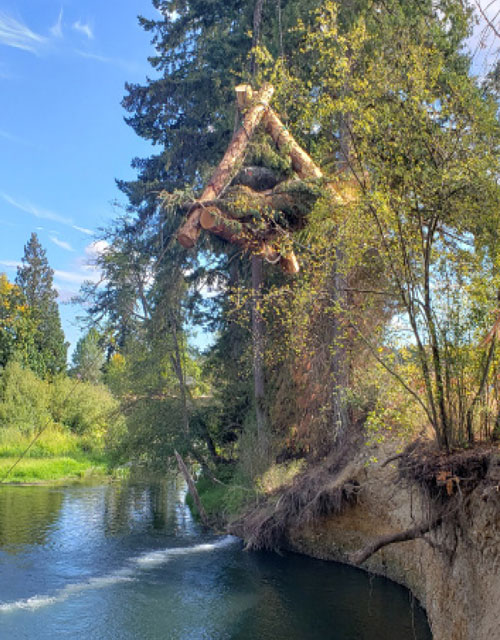
American Public Works Association | 2022 Project of the Year
Category: Emergency | Division: Less than $5 Million

Tunista Construction was awarded Project of the Year for our successful completion of the Newaukum Valley Road Stabilization Project in Lewis County, partnering with the Lewis County Public Works Department, NHC Hydraulic Consultants as the DOR and FEMA. This project was awarded Project of The Year by the American Public Works Association for the category of Emergency Repair Under $5 Million and was successfully completed at the end of 2021. This award is a testament to the incredible effort by our staff, a strong collaborative partnering effort with the Lewis County Public Works Department and the Designer of Record, NHC Hydraulic Consultants and we are honored to have been recognized for it.
The Newaukum Valley Road Bank Stabilization project site is located approximately six miles southwest of Chehalis in Lewis County, Washington. At the site, the Newaukum Valley Road is a single lane per direction roadway that provides local and emergency access to the area.
The Newaukum River at the project site features a sharp, 180-degree bend that has migrated approximately 95 feet to the west between 2012 and 2019. During the 2019 storm season, the river avulsed and cut off the bend, changing flow patterns along the left bank and beginning erosion towards the roadway. A storm in early 2020 produced high river levels, cutting off the natural bend in the river and resulting in increased velocity of these higher river flows.
With nothing left to divert its higher velocity flow away from the crumbling road embankment, the river began to significantly erode the bank – creating an imminent danger to public safety and threatening failure of the roadway infrastructure. At the request of Public Works officials, the Board of County Commissioners declared a state of emergency for the site.
With the state of emergency in place, Public Works expedited engineering and permitting as county staff identified potential solutions. Lewis County was also able to secure Federal Emergency Management Agency (FEMA) funds for the design and construction. The high level of coordination required amongst various agencies and individuals meant that it was imperative to quickly accomplish preliminary items such as hydraulic analysis and environmental impact permitting.
Within three months, Northwest Hydraulic Consultants (NHC) completed analysis and design of an innovative, modular system of ballasted log jacks. Tunista Construction maximized construction efficiency by assembling the log jacks off-site—thereby limiting road closures and instream construction disturbances to a few days. The entire bank stabilization project was designed and constructed in less than seven months, from March to October 2021.
River Flow 2009 – 2021
Construction Management
This project required vast experience, robust planning, and extreme nimbleness due to the urgency of the timeline. The key to remaining flexible and adjusting to changes in plans was communication amongst the entire project team. Lewis County Public Works Department, NHC, and Tunista Construction staff developed a strong collaborative mindset from the outset of the first project meeting. This partnership was integral to the successful completion of the project.
Tunista Construction generated submittals, collaborated on design and constructability requirements, began procurement, and rapidly mobilized within 48 hours to meet the required dates for performance and in-water work. In addition to the limited number of in-water working days allotted for the installation of the log jacks, the contract also had strict environmental, historical, archeological, and seasonal fish management requirements.
Other key factors in the primary construction and sequence effort was minimizing the amount of time that the crane spent on the roadway and maximizing efficiency in placing the log jacks—reducing site impacts and traffic disruptions. The log jacks were assembled in advance a few miles from the project site in order to optimize installation during the in-water work window. The installation also used a perimeter bubble curtain—placed in the river prior to completion of a full fish exclusion process—which ran continuously from commencement through completion of the in-water work.
Tunista’s rapid project planning, stakeholder collaboration, and management efforts yielded a net reduction of 11 days out of a 45-day contract window—successfully completing the project 18 days before the anticipated completion date.
Assembling the Log Jacks
Safety Performance
Tunista Construction’s safety program addressed concerns related to COVID-19 transmission at the worksite, irregular and uncertain interactions of materials during assembly, in-water work hazards, overhead lifting safety, and traffic management.
Tunista specifically focused on the safe performance of this contract, proactively managing safety using proven tools such as a start-of-shift Active Hazard Analysis (AHA); daily “game plan” review with the construction crew and superintendent; and pre-lift planning for the log jack assembly, transportation, rotation, and placement using Snell Crane’s LTR1100, a 110-ton Crawler crane. Tunista ensured this was a Zero Incident Project with no injuries, near misses, environmental damage, or unsafe conduct on this project.

Tunista Construction’s safety program and management ensured that the bank stabilization was a Zero-Incident Project.

Community Relations
Lewis County Public Works Department and Tunista Construction engaged and communicated with local landowners before, during, and after the completion of the project to improve relations with the public. Tunista also developed a good relationship with local homeowners most severely impacted by the road outage during construction.
Newaukum Valley Road is a critical roadway for both the local community and emergency services. Minimizing the roadway closure during construction was very important because the detour route added up to 10 minutes for Lewis County Fire District No. 5 emergency and paramedic response time as well as 10 miles additional travel distance for school bus service and locals living near the project site. Tunista partnered with a local farming family to lease the land used to assemble, test, and inspect the log jacks instead of using the road as a staging area—a strategy that minimized road closure time to 14 days.

Environmental Awareness
The bubble curtain provided a deterrent to aquatic species entering the work area during construction.
Log jacks protect the river bank and provide protection and habitat for aquatic species.

Environmental protection was one of the highest priorities of this project. NHC considered many different types of bank protection, including a wall, rock revetment, or bioengineered structure. Ultimately, bioengineered structures were chosen due to their ability to encourage natural processes that provide immediate enhancement of instream habitat for aquatic species and aid in long-term bank protection.
The bank stabilization design consisted of an interlocked system of ballasted log jacks. Ballasted log jacks are individual units consisting of log members connected and ballasted by a single boulder. When installed, the log jack units are placed directly adjacent to or on top of each other to create an interlocked, flexible, woodbased bank protection structure. The log jack design provides and recruits additional natural debris to provide cover for fish and other aquatic species.
In-situ placement of bioengineered structures can require dewatering or site isolation, temporarily reducing accessible habitat area and increasing turbidity during construction. Instead, a bubble curtain was utilized. The bubble curtain deterred aquatic species from entering the work area, and installation and removal resulted in minimal in-water disturbance. Additionally, placement of the log jack structures was completed with great care: the jacks were lowered into the water and onto the channel bed slowly, resulting in near-zero bed disturbances or increases in turbidity. Overall, the log jack design and the installation method required only 7 in-water work days, minimizing instream impacts.
Adverse Conditions
Adverse conditions at the project site included a near-vertical bank (approximately 30 feet tall) in extremely close proximity to the roadway and water depths of over 10 feet. Accessing the toe of the slope from the bank or river side would be cost- and logistically-prohibitive, and dewatering or water isolation to install bank protection features in-situ “in the dry” would be nearly impossible. NHC developed a solution that could be built on land and placed in the water using a crane from the top of the bank, thereby minimizing both construction costs and stream impacts.
Additional Considerations
Log jacks were designed to be stable and provide bank protection for a range of probable hydraulic conditions specific to the project site, requiring relatively large ballast boulders to withstand hydrodynamic forces during high flow events. Unlike log jams or revetments assembled in-situ, log jacks can be assembled adjacent to or off-site and transported for placement. At the Newaukum Valley Road site, Lewis County Public Works sought to avoid ground disturbance in areas adjacent to the river, thereby making off-site assembly of the bank protection paramount to the project. Tunista Construction was able to secure and prepare a construction and staging area within a 10-minute drive of the site, not only avoiding ground disturbances but also minimizing closures on this important County road.
Commitment to Sustainability
Log jacks tightly interlock during construction to minimize void space while increasing bank roughness and providing valuable aquatic habitat. As the river naturally transports sediment and debris, those materials will settle into the lower velocity zones within the jacks, collecting natural materials and providing future protection to the vulnerable bank. Log jacks are also adaptable and will adjust with the channel based on local scour patterns and processes. As natural river processes continue, the log jacks can settle into the channel bed to provide bank protection even as channel conditions change.


























